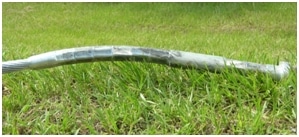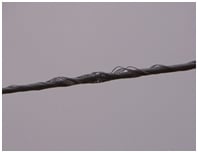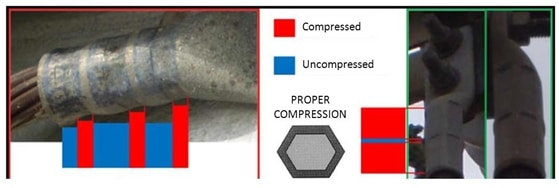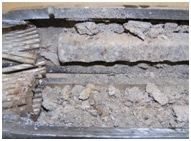Hi fellows, here’s an article from Pablo M. who’ve already wrote for us in the past. Enjoy and ask him questions if you want to :)
Hello it’s Pablo,
This time I will share with you the most common problems and mistakes found in the installation of compression connectors and how to avoid them. Note that this is a summary since full training is needed to ensure proper connection.
Bowed conductors
Bow refers to the curvature may occur in a compression connection after being installed. Bowing is sometimes caused by the natural curvature of the conductor (caused by storage on a reel).
During the compression process, the compression material enters into a “plastic” state and can be easily influenced to bend with little force.
A lot of compressions on the connector may cause excessive bowing. Broken dies is another cause. Therefore, if no opposition, the conductor shall tendency to bend causing the appearance of a curvature in the final connection.
How to avoid this?
There are two (2) ways to reduce or eliminate bowing:
First, whenever possible, the conductor should be straightened before being inserted into the connector. Straighten the conductor eliminates the primary force causing arcing.
Second, the operator can carefully apply by hand an opposing force to the arc direction to straighten the connector. Little effort is needed, while the materials are being compressed, to counteract the tendency to warp the connector. Besides must ensure the proper condition of the tools and the right training for lineman.
Birdcage
The bird cage effect refers to the separation of the wires of a stranded conductor at the input of compression sleeve. This phenomenon occurs when two (2) or more metals with different physical properties are extruded together, such as in the process of installing a compression connector when the connector sleeve and the conductor are not the same.
The result of the different rates of extrusion is uneven plastic deformation, and when a material is a stranded conductor, the individual strands can be separated.
How to avoid this?
The bird cage effect has no detrimental effect on the global connection. However, it is desirable to minimize or eliminate this condition to avoid areas that could produce crown or make an unequal distribution of power out connection.
One of the methods used to remove the bird cage is to use a connector designed to be compressed from the outermost position. This type of compression connector should have holes to relieve pressure in the center of the handle; this is to allow the exit of excess rust inhibitor.
Space between compressions
Spaced compressions refer to the case in which the individual compressions are made separately, in distinguishable locations along the compression sleeve. Overlapping compressions are made such that compression overlap approximately ¼ the above compression.
In high voltage applications compressions will be made overlapping, the part that has been compressed must have a uniform surface. The edges should be removed with a file or sandpaper. In low voltage applications, including grounding spaced compressions are allowed.
Regardless of the method used, compressions should not be performed at conical ends or beyond compression lines, and should be completed a specific number of compressions.
Do you think that the above connections are made right or wrong?
Not enough electric compound
The best job that anyone can do when brushing a conductor to be electrically connected, is cleaning the outer surfaces of the outer strands of the conductor. Internal threads are covered with oxides and cannot be removed without unraveling the conductor.
Some inhibitors are provided with oxide particles in suspension which have conductive characteristics such as zinc or nickel. The function of these particles is drill through the oxide covering the inside of the strands of the conductor and make contact with the clean metal between each strand.
The particles act like little shunts, which connect the inner conductor strands between them, and their outer strands. This allows more strands to participate in the current transport thereby maximize the efficiency of the connection.
However when this compound is not used the following problems appear:
- If there is any cavity that is not filled with inhibitor compound, the water will eventually find its way into these spaces and will increase corrosion.
- Lack of compound produces a high initial contact resistance, resulting in a lower conductivity and hence a rise in the temperature of the connector
- Arcing between strands
Direction of compression
Whether it is a joint, a terminal or a branch is never recommended reverse compression unless a special connector is available for it. In the case of a terminal is normal practice to start from the middle of the connector; compression is done on alternate sides, heading the ends of the connection.
Compression of terminals must start from the closest point to the flat surface (tongue). In a branch start compressions from the middle of the connector it is generally a good practice.
Finally I want to mention that the best practice will always be prevention to avoid possible damage to expensive equipment such as a power transformer.
Pablo M.







I really like what you guys tend to be up too.
This sort of clever work and exposure! Keep up the excellent works
guys I’ve included you guys to blogroll.